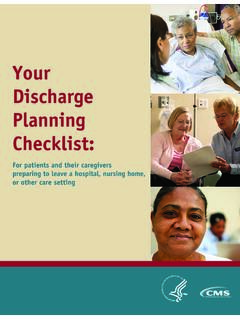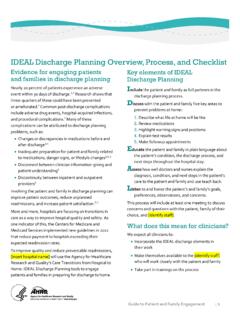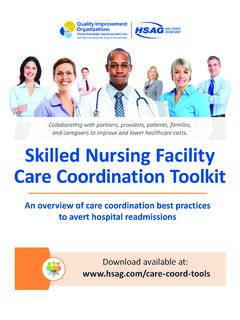Transcription of DISCHARGE PLANNING TOOLKIT - Lifespan Network
1 1 DISCHARGE PLANNING TOOLKIT This TOOLKIT is offered by The Beacon Institute through a grant from the Maryland Office of Health Care Quality 2 DISCHARGE PLANNING TOOLKIT TABLE OF CONTENTS Introduction SECTION I: STAFF RESOURCES New Requirements for DISCHARGE PLANNING Includes information on the new Mega-Rule requirements for DISCHARGE PLANNING that became effective 11/28/17. Procedure/ checklist for DISCHARGE PLANNING Tool for monitoring completion of new Mega-Rule requirements DISCHARGE PLANNING checklist List of actions to consider prior to and on the day of DISCHARGE Assessment of Post- DISCHARGE Needs checklist of items to include in a DISCHARGE plan Readmission Risk Worksheet Listing of factors for increased risk of hospital readmission. DISCHARGE Care Plan Care plan that can be used as is, or incorporated into facility s care plan format. Being Sensitive to Cultural Differences Factors to consider in respect to individuals' beliefs and practices; web resources to gain insights about specific groups Resident and Caregiver Education Review of items which need to be considered for effective education on post- DISCHARGE care.
2 DISCHARGE PLANNING : Diabetic Management checklist Listing to ensure inclusion of essential information needed for disease management. Medication Reconciliation Blank template Medication Administration Schedule Blank Template DISCHARGE Summary Suggested Content General guideline for DISCHARGE documentation. DISCHARGE Summary (Form) Blank form that can be completed and copied for resident/family/continuing care providers. Online Resources for DISCHARGE PLANNING /Preparation Listing of web resources with useful information for staff, resident, or caregiver during the process of DISCHARGE PLANNING . 4 DISCHARGE PLANNING TOOLKIT INTRODUCTION DISCHARGE PLANNING involves a coordinated effort between the patient/resident, caregiving professionals, family members, and community supports. It is intended to smooth the transition from facility care to a home setting, or alternate facility. Increased attention is being focused at DISCHARGE processes due to post- DISCHARGE complications and re-admissions.
3 According to literature reports: 20% of patients experience adverse events within 30 days of dischargefrom hospitals 18% of Medicare patients are readmitted within 30 days of DISCHARGE 40% of patients > 65 years old experience post- DISCHARGE medicationerrors 30% of nursing homes have been found to be non-compliant with therequirements for DISCHARGE planningIn November of 2017, new requirements for DISCHARGE PLANNING became effective with the implementation of the new Mega Rule. It is important for facilities to review their current DISCHARGE PLANNING processes and make revisions as necessary for regulatory compliance and for improved quality. These new requirements place increased emphasis on patient goals and preferences, and preparations to coordinate appropriate supports to meet those goals. Post- DISCHARGE needs are often multi-factorial, and often include education of the resident and family on health conditions, medications, and follow-up care. Support services may involve both clinical and-non-clinical services and be directed at not only the patient, but family caregivers as well.
4 Special attention must also be given to assess the readiness of the family to assume the caregiving role and the impact that caregiving will have. Because of the number and variety of activities that must be carried out, and the number of people/disciplines involved, quality improvement initiatives for DISCHARGE PLANNING strongly recommend the use of checklists and tools to assure that all needs have been addressed. The purpose of this TOOLKIT is to provide practical information and resources to facilitate and support facility efforts to meet DISCHARGE PLANNING needs. 5 SECTION I: STAFF RESOURCES NEW REQUIREMENTS FOR DISCHARGE PLANNING F660 (new) (old tag = F284) (c) (1) DISCHARGE PLANNING Process The facility must develop and implement an effective DISCHARGE PLANNING process that focuses on the resident s DISCHARGE goals, the preparation of residents to be active partners, and effectively transition them to post- DISCHARGE care, and the reduction of factors leading to preventable readmissions.
5 The facility s DISCHARGE PLANNING process must be consistent with the DISCHARGE rights set for at (b) as applicable, and (i)Ensure that the DISCHARGE needs of each resident are identified and result in thedevelopment of a DISCHARGE plan for each resident(ii)Include regular re-evaluation of residents to identify changes that requiremodification of the DISCHARGE plan. The DISCHARGE plan must be updated, as needed,to reflect those changes.(iii)Involve the interdisciplinary team, as defined by (b) (2) (ii), in the ongoingprocess of developing the DISCHARGE plan(iv)Consider caregiver/support person availability and the resident s orcaregiver s/support person(s) capacity and capability to perform required care, aspart of the identification of DISCHARGE needs.(v)Involve the resident and resident representative in the development of the dischargeplan and inform the resident and resident representative of the final plan(vi)Address the resident s goals of care and treatment preferences.
6 (vii)Document that the resident has been asked about their interest in receivinginformation regarding returning to the community.(A) If the resident indicates an interest in returning to the community, the facility mustdocument any referrals to local contact agencies or other appropriate entities madefor this purpose.(B) Facilities must update a resident s comprehensive care plan and DISCHARGE plan, asappropriate, in response to information received from referrals to local agencies orother appropriate entities.(C) If DISCHARGE to the community is determined to not be feasible, the facility mustdocument who made the determination and why.(viii)For residents who are transferred to another SNF or who are discharged to a HHA,IRF, or LTCH, assist residents and their resident representatives in selecting a post-acute care provider by using data that includes, but is not limited to SNF (skillednursing facility), HHA (home health agency), IRF (inpatient rehab facility), or LTCH(long-term care hospital) standardized patient assessment data, data on qualitymeasures, and data on resource use to the extent the data is available.
7 The facilitymust ensure that the post-acute care standardized patient assessment data, data 6 on quality measures, and data on resource use is relevant and applicable to the resident s goals of care and treatment preferences. (ix) Document, complete on a timely basis based on the resident s needs, and include in the clinical record, the evaluation of the resident s DISCHARGE needs and DISCHARGE plan. The results of the evaluation must be discussed with the resident or resident s representative. All relevant resident information must be incorporated into the DISCHARGE plan to facilitate its implementation and to avoid unnecessary delays in the resident DISCHARGE or transfer. Key Points from Interpretive Guidelines for (c) (1) DISCHARGE PLANNING Process The DISCHARGE care plan is part of the comprehensive care plan and must: o Be developed by the interdisciplinary team o Involve direct communication with resident (and/or resident s representative) o Identify needs that must be addressed prior to DISCHARGE (such as education, rehabilitation, caregiver support/education) o Be re-evaluated regularly and updated when the resident s needs or goals change o Document resident s interest in, and any referrals made to local agencies o Identify post- DISCHARGE needs (nursing, therapy services, medical equipment, modifications to the home, ADL assistance) For residents who want to be discharged to the community o Family members, significant others or the resident s representative should be involved in this determination (with the resident s permission)
8 , unless the resident is unable to participate in the DISCHARGE PLANNING process o The nursing home is responsible for making referrals o The resident, and if applicable, the resident s representative, should be made aware that the local ombudsman is available to provide information and assist with any transitions from the nursing home. For those who want to be discharged to another SNF, HHA, IRF, or LTCH the facility must: o Provide assistance in finding an appropriate provider that will meet the resident s needs, goals, and preferences o Provide publicly available standardized quality data (such as CMS Nursing Home Compare), and resource use data as available (example number of residents discharged, preventable infection rates, etc.) and guidance in helping the resident/family understand data 7 PROCEDURE/ checklist FOR DISCHARGE PLANNING TASK DATE INITIAL LOCATION OF INFORMATION Explore/document the resident s interest in receiving information about DISCHARGE to the community.
9 Determine resident goals & preferences. Perform assessment of DISCHARGE needs KNOWLEDGE/MANAGEMENT OF MEDICAL CONDITION Perform assessment of DISCHARGE needs MEDICATION KNOWLEDGE AND MANAGEMENT Perform assessment of DISCHARGE needs PHYSICAL FUNCTIONING Perform assessment of DISCHARGE needs COMPLETION OF IADL tasks Perform assessment of DISCHARGE needs HOME MODIFICATIONS Perform assessment of DISCHARGE needs MEDICAL EQUIPMENT Perform assessment of DISCHARGE needs HOME HEALTH SERVICES Perform assessment of DISCHARGE needs NON-CLINICAL HOME SUPPORT SERVICES Perform assessment of DISCHARGE needs F/U APPOINTMENTS Perform assessment of DISCHARGE needs COMMUNITY SUPPORT Determine available capacity and capability of family/caregiver support Interdisciplinary DISCHARGE plan developed with input of resident and resident representative DISCHARGE plan addresses all resident goals and preferences Document all referrals and response to referrals Provide standardized quality and resource data
10 For SNF, HHA, IRF, LTCH as available. 8 TASK DATE INITIAL LOCATION OF INFORMATION Document re-evaluation of DISCHARGE plan and updates to resident/family If DISCHARGE is determined infeasible, document who made that determination and reasons why. Additional comments: 10 Encourage and address questions. 11 ASSESSMENT OF POST- DISCHARGE NEEDS Resident: _____Anticipated DISCHARGE Date: _____ Consider needs in each of the following areas to identify specific needs to be included in the DISCHARGE plan: Medical Condition: _____ Type of care and/or monitoring needed _____ Follow-up appointments _____ Home health services _____ Special equipment and supplies _____ Medication management Physical Function: _____ Limitations _____ ADL/IADL support needed _____ Home modifications needed _____ Non-clinical home services needed Mental Capacity: _____ Cognitive function _____ Education level/Understanding of condition and care _____ Mood/Motivation Lifestyle: _____ Usual daily/weekly routines _____ Eating habits/food choices _____ Physical activity/exercise _____ Impact of condition on lifestyle _____ Realistic goals and expectations Safe Housing: _____ Appropriate housing available _____ Home caregiver available Home Environment.







